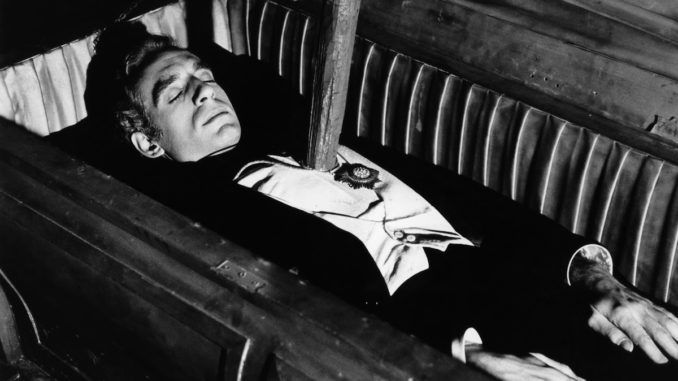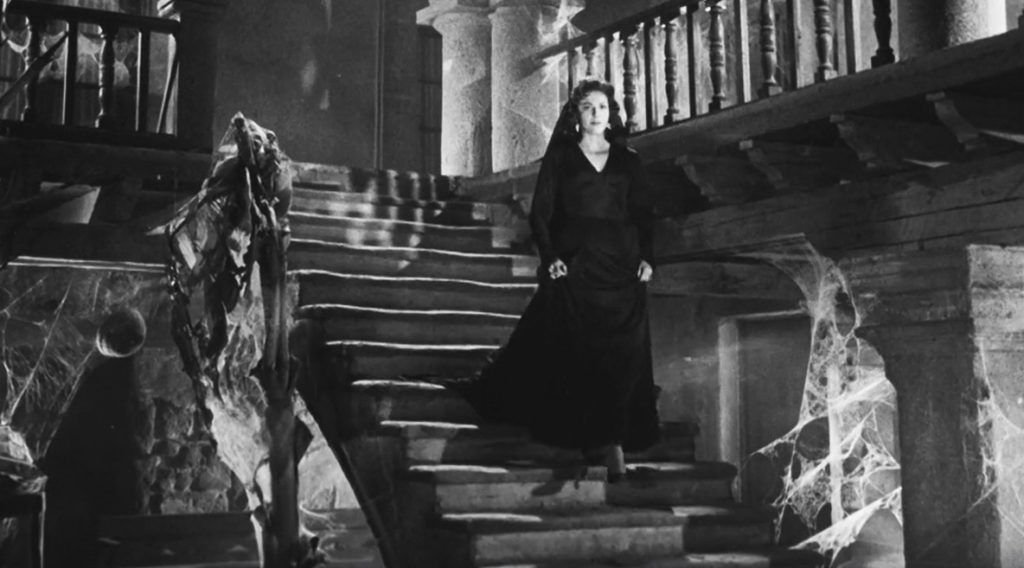
Rating: B
Dir: Fernando Méndez
Star: Abel Salazar, Ariadne Welter, Carmen Montejo, Germán Robles
A year before Christopher Lee and Peter Cushing resurrected the vampire genre in the English-speaking world, something similar happened on the other side of the world. As we already noted, the Spanish language version of Universal’s Dracula was a big hit in Latin America, playing for decades. But rather than a copy, El vampiro is an authentically Hispanic, original work. Like Hammer’s Dracula, it was a significant instigator in kicking off a subsequent wave of locally produced horror films over the next decade or more.
It begins with the arrival by train in Sierra Negra, a small rural town, of travelling salesman Enrique (Salazar) and returning native Marta (Welter). Darkness is falling and they’re stuck at the station because the locals refuse to go out after dusk. Fortunately, a coach shows up to collect a box which was arriving on the same train, intended for delivery to Count Lavud (Robles). It’s a box of soil from Hungary. Add that the Count, unlike the locals, only goes out after dark, plus always wears a long cape, and he pretty much has hit the trifecta of “You might be a vampire…” signs. No-one here even mentions it, naturally.
 His minion kindly drops Enrique and Marta off within walking distance of her family home, Los Sicomorros. She was returning there, having been summoned due to the illness of her aunt, Maria Teresa. As they head for the hacienda, they’re followed by a lady in black, who keeps phasing in and out. She turns out to be another aunt, Eloisa (Montejo), who looks exactly like she did when Marta last saw her, decades ago. Yeah, that’s not suspicious in the least either. On arriving, Marta learns Maria Teresa had died, having been buried this morning, and we discover Enrique isn’t the commercial traveller he claimed to be. He’s a doctor who had been called for to tend to the ailing woman, due to her paranoid concerns about predatory vampires. So both visitors have shown up a bit late to the party, frankly.
His minion kindly drops Enrique and Marta off within walking distance of her family home, Los Sicomorros. She was returning there, having been summoned due to the illness of her aunt, Maria Teresa. As they head for the hacienda, they’re followed by a lady in black, who keeps phasing in and out. She turns out to be another aunt, Eloisa (Montejo), who looks exactly like she did when Marta last saw her, decades ago. Yeah, that’s not suspicious in the least either. On arriving, Marta learns Maria Teresa had died, having been buried this morning, and we discover Enrique isn’t the commercial traveller he claimed to be. He’s a doctor who had been called for to tend to the ailing woman, due to her paranoid concerns about predatory vampires. So both visitors have shown up a bit late to the party, frankly.
Maria Teresa willed Marta her share in Los Sicomorros, but Eloisa is very keen to sell it to the Count. He wants to resurrect his vampiric brother, a previous owner of the estate who terrorized the area a hundred years ago, until he was staked by locals and buried in the crypt. The newly-arrived soil is key to this, and to avoid anyone making a connection, Count Lavud is now going by the name of Duval. Nobody could possibly see through that pseudonym, could they? Marta grows suspicious of Eloisa, after initially shrugging off her non-appearance in mirrors (really, everyone here is remarkably blasé). Meanwhile, Maria Teresa is not as dead as reported, since Marta sees her most definitely above ground, and seems to have her niece’s best interest at heart, e.g. helpfully leaving a cross on her pillow.
The version of the mythology in play here states that a vampire must feed a victim twice in order to turn them. Although the Count gets his first nibble in on Marta, he is unable to complete the conversion. He battles with Enrique, then is forced to flee by the arrival of dawn. In an unusually feminist twist – particularly for Mexico in the fifties – it’s Maria Teresa who stakes Lavud in his coffin, having previously taken care of Eloisa too. Oddly, while it is mentioned you can’t shoot a vampire or kill them in other normal ways, good ol’ manual strangulation does the trick perfectly well on Eloisa. Not sure I’ve seen it work anywhere else, and she reverts to a skeleton on the dispatch of her creator.
The original Mexican entry was going to be Santo vs. las Mujeres Vampiro, until Chris pulled a face, and I’m glad she did. This is certainly far less cheesy, and makes up for the lack of lucha libre with genuine atmosphere, and good performances. If the two leads may not be quite at the Lee/Cushing level, the supporting cast is excellent. Particularly impressive was Mercedes Soler as the family maid, Mrs. Santoyo. She has to deliver the whole back-story to Enrique, and sells it with conviction. Actually, all the actresses are arguably better than in Hammer’s first take. Montejo cuts an especially striking figure in her mourning black gown, which with its long train, looks like a Goth wedding dress. Alicia Montoya is also good value as the mad, entirely correct, woman. She’d be completely forgiven for yelling “I told you!” as she stakes Lavud.
 On the male side, the Spanish-born Robles was still only on his twenties when he made this, but plays the part of the Count considerably older. Both he and Salazar subsequently stayed in the horror genre, such as Robles playing vampire Nostradamus (don’t ask…). In addition, he was a long time dubber of movies and TV shows in Latin America – Robles was the voice there of Kitt in Knight Rider. Similarly Salazar, who produced this as well as starring in it, would go on to be involved in other vampire films. They included the sequel to this, El ataúd del Vampiro (The Vampire’s Coffin), which was made the following year and reunited him with Robles and Welter under director Méndez.
On the male side, the Spanish-born Robles was still only on his twenties when he made this, but plays the part of the Count considerably older. Both he and Salazar subsequently stayed in the horror genre, such as Robles playing vampire Nostradamus (don’t ask…). In addition, he was a long time dubber of movies and TV shows in Latin America – Robles was the voice there of Kitt in Knight Rider. Similarly Salazar, who produced this as well as starring in it, would go on to be involved in other vampire films. They included the sequel to this, El ataúd del Vampiro (The Vampire’s Coffin), which was made the following year and reunited him with Robles and Welter under director Méndez.
I enjoyed this one so much, I’m going to have to check the sequel out. Admittedly, this is partly due to low expectations, courtesy of Santo. Yet by any standards this is solid cinema. The limited budget is occasionally obvious: most of the FX are about the Georges Méliès level. Yet other elements are top-shelf, such as Rosalio Solano’s photography and Gustavo Cesar’s soundtrack, both of which stand up well today. I wouldn’t go quite so far as to say it stands alongside Terence Fisher’s classic. But it definitely does not deserve to be as overlooked in cinema history, as it appears to be.
This review is part of our October 2023 feature, 31 Days of Vampires.
